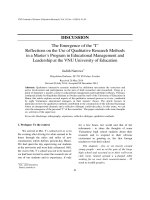research methods in economicskte02009
Bạn đang xem bản rút gọn của tài liệu. Xem và tải ngay bản đầy đủ của tài liệu tại đây (714.51 KB, 12 trang )
<span class='text_page_counter'>(1)</span><div class='page_container' data-page=1>
RESEARCH METHODS
IN ECONOMICS
(KTE02009)
H O N G O C N I N H , P H D .
D E PA R T M E N T O F P L A N N I N G A N D I N V E S T M E N T
FA C U LT Y O F E C O N O M I C S A N D R U R A L D E V E L O P M E N T, V N U A
<b>FACULTY OF ECONOMICS AND RURAL DEVELOPMENT - VNUA</b>
<i>Lecturer information: </i>
Dr. Ho Ngoc Ninh
Dept. of Planning and Investment
Faculty of Economics and Rural Development
Vietnam National University of Agriculture
Email:
</div>
<span class='text_page_counter'>(2)</span><div class='page_container' data-page=2>
<i><b>- On knowledge: </b></i>To teach students to understand the basic theories about research
methods in economics: Basic concepts, research process, research structure, main
elements, contents of research; Understand and apply basic and professional
research methods in the field of socio-economics and business management.
<i><b>- On skills: </b></i>To train students how to organize independent research and group
research effectively; and use professional softwares in analyzing, evaluating
information for conducting research.
<i><b>- On attitude and responsibility:</b></i>To form activation and responsibility in activities,
contents and research outcomes in the field of socio-economics and business
management.
References for the course
<b>1.</b> <b>Research methods in economics lecture note</b>. Department of Planning and
Investment, Faculty of Economics and Rural Development, Vietnam National
University of Agriculture.
2. Kothari, C.R. (2004). <b>Research Methodology: Methods and Techniques</b>. New
Age International (P) Ltd., Publishers.
3. Mark Saunders, Philip Lewis and Adrian Thornhill (2009). <b>Research Methods </b>
<b>for Bunisess Students</b>, Pearson Education Limited, ISBN 978-0-273-71686-0,
573pp.
</div>
<span class='text_page_counter'>(3)</span><div class='page_container' data-page=3>
<b>Website for lecture notes and assignments: </b>
Useful website
-<b>Research Methods For Business Students (30 short videos, all students required</b>
<b>to </b>
<b>watch). /><b>FHK1ak8xK1dRowlv1pm3tS</b>
<b>- Topic 5: Sampling: /><b>- Statistics Lecture 1.5: Sampling Techniques. How to Develop a Random </b>
<b>Sample. />
<b>- Topic 11: Qualitative Data Analysis. </b>
<b> />
<b>- Multidimensional poverty in Viet Nam: Reducing poverty in all its dimensions to </b>
<b>ensure a good life for all .</b>
</div>
<span class='text_page_counter'>(4)</span><div class='page_container' data-page=4>
Useful website
<b>Secondary sources:</b>
Google:
Resources for Economists: />
LexisNexis: => “Most Used Databases” => “LexisNexis News”
<b>Primary sources: Working papers</b>
◦ Research Papers in Economics (RePEc): (also has links to
published journal articles)
◦ Social Science Research Network (SSRN):
◦ National Bureau of Economic Research (NBER): />Facebook: Nhóm tải báo account
Introduction to research
methods in economics
<b>Chapter 1: Introduction to research methods in economics</b>
<b>Chapter 2: Research Design</b>
<b>Chapter 3: Data Collection Methods</b>
<b>Chapter 4: Data Processing and Analysis</b>
</div>
<span class='text_page_counter'>(5)</span><div class='page_container' data-page=5>
<b>Chapter 1: Introduction to research </b>
<b>methods in economics</b>
Meaning of Research
Objectives of Research
Motivation in Research
Types of Research
Research Approaches
Significance of Research
Research Methods versus Methodology
What is research ?
Research is something that people undertake in order to
find out in systematic way, thereby increasing their
knowledge.
Research = creation of knowledge
How to create knowledge
◦ Construct an argument
◦ Argument must be a position or point of view on a question
◦ Argument must be supported by evidence
</div>
<span class='text_page_counter'>(6)</span><div class='page_container' data-page=6>
11
<b>Why Do Research?</b>
Summarizing what is known in a field
Contributing to knowledge on a topic
Solving a problem/puzzle
Weighing in on a debate
More…..
<b>Motivation in research</b>
What makes people to undertake research?
Desire to get a research degree along with its consequential
benefits;
Desire to face the challenge in solving the unsolved problems, i.e.,
concern over practical problems initiates research;
Desire to get intellectual joy of doing some creative work;
Desire to be of service to society;
Desire to get respectability.
</div>
<span class='text_page_counter'>(7)</span><div class='page_container' data-page=7>
13
TYPES OF RESEARCH
<b>1) Descriptive vs. Analytical</b>
<i>Descriptive research </i>
includes surveys and
fact-finding enquiries of different kinds. The major
purpose of descriptive research is description of
the state of affairs as it exists at present.
<i>Analytical research</i>
, on the other hand, the
researcher has to use facts or information
already available, and analyze these to make a
critical evaluation of the material.
TYPES OF RESEARCH
<b>Basic research</b> <b>vs</b> <b>Applied research</b>
Intention
To expand general
knowledge of
processes
To improve the
understanding of
particular problem
Result Universal principles Solution to a particular
problem
</div>
<span class='text_page_counter'>(8)</span><div class='page_container' data-page=8>
TYPES OF RESEARCH
3)
<b>Quantitative vs. Qualitative</b>
Quantitative research is based on the measurement of quantity
or amount. It is applicable to phenomena that can be expressed in
terms of quantity.
Qualitative research, on the other hand, is concerned with
qualitative phenomenon, i.e., phenomena relating to or involving
quality or kind
TYPES OF RESEARCH
4)
Conceptual vs. Empirical
Conceptual research is that related to some
abstract idea(s) or theory. It is generally used
by philosophers and thinkers to develop new
concepts or to reinterpret existing ones.
Empirical research relies on experience or
</div>
<span class='text_page_counter'>(9)</span><div class='page_container' data-page=9>
Research Approaches
There are two basic approaches to research, viz., <i>quantitative approach</i>
and the<i>qualitative approach</i>.
1. Quantitative approach involves the generation of data in quantitative
form which can be subjected to rigorous quantitative analysis in a
formal and rigid fashion. This approach can be further sub-classified
into<i>inferential</i>,<i>experimental</i>and<i>simulation approaches</i>to research.
<i>2.</i> <i>Qualitative approach</i> to research is concerned with subjective
assessment of attitudes, opinions and behaviour. Research in such a
situation is a function of researcher’s insights and impressions.
Research Methods versus Methodology
<i>1) Research methods</i>
may be understood as all those
methods/techniques that are used for conduction of
research.
<i>Research methods or techniques</i>
,
<i>thus</i>
,
<i>refer to</i>
<i>the methods the researchers use in performing research</i>
<i>operations</i>
.
<i>Research techniques</i> refer to the behaviour and instruments we use in
performing research operations such as making observations, recording
data, techniques of processing data and the like.
</div>
<span class='text_page_counter'>(10)</span><div class='page_container' data-page=10>
Research Methods versus Methodology
Research methodology
<i>1) Research methodology</i> is a way to systematically solve the research
problem.
2) It may be understood as a science of studying how research is done
scientifically. In it we study the various steps that are generally adopted
by a researcher in studying his research problem along with the logic
behind them.
</div>
<span class='text_page_counter'>(11)</span><div class='page_container' data-page=11>
<b>1.</b> <b>Good research is systematic </b>
It means that research is structured with specified steps to
be taken in a specified sequence in accordance with the well defined set of rules.
Systematic characteristic of the research does not rule out creative thinking but it
certainly does reject the use of guessing and intuition in arriving at conclusions.
<b>2.</b> <b>Good research is logical </b>
This implies that research is guided by the rules of logical reasoning and the
logical process of induction and deduction are of great value in carrying out
research.
<b>3.</b> <b>Good research is empirical </b>
It implies that research is related basically to one or more aspects of a real
situation and deals with concrete data that provides a basis for external validity to
research results.
<b>4.</b> <b>Good research is replicable</b>
<b>T</b>his characteristic allows research results to be verified by replicating the study
and thereby building a sound basis for decisions.
Criteria of good research
Reading Exercise
All students have to read chapter 1 of the reference:
Kothari, C.R. (2004). <b>Research Methodology: Methods and Techniques</b>. New
Age International (P) Ltd., Publishers.
/>
All students have to watch movies 1.1-1.3 of the reference “Research Methods
For Business Students” from youtube.com:
</div>
<span class='text_page_counter'>(12)</span><div class='page_container' data-page=12></div>
<!--links-->









